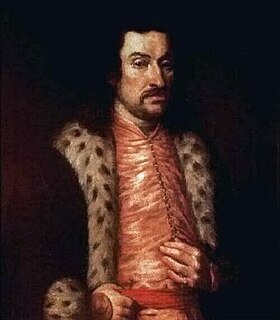 W
WStefan Czarniecki was a Polish nobleman, general and military commander. In his career, he rose from a petty nobleman to a magnate holding one of the highest offices in the Commonwealth, something that was unprecedented in the Commonwealth history. On 22 July 1664 he received the office of the voivode of Kiev and on 2 January 1665, a few weeks before his death, he was given the office of Field Hetman of the Crown of the Polish Kingdom. He is remembered as an accomplished military commander, and regarded as a Polish national hero. His status in Polish history is acknowledged by a mention of his name in the Polish national anthem.
 W
WWincenty Aleksander Korwin Gosiewski de armis Ślepowron – was a Polish nobleman, general, Field-Commander of Lithuania from 1654, Grand Treasurer of Lithuania and Lithuanian Great-Quartermaster since 1652, General of Artillery of Lithuania from 1651, Grand-Master of the Pantry of Lithuania from 1646.
 W
WPrince Jeremi Wiśniowiecki nicknamed Hammer on the Cossacks, was a notable member of the aristocracy of the Polish–Lithuanian Commonwealth, Prince of Wiśniowiec, Łubnie and Chorol in the Crown of the Kingdom of Poland and the father of the future King of Poland, Michael I.
 W
WJohn II Casimir was King of Poland and Grand Duke of Lithuania from 1648 until his abdication in 1668 as well as titular King of Sweden from 1648 until 1660. He was the second son of Sigismund III Vasa and Constance of Austria. His older brother and predecessor on the throne was Władysław IV Vasa.
 W
WMarcin Kalinowski was a Polish magnate and nobleman (szlachcic), Kalinowa coat of arms, Field Crown Hetman. He was the son of Walenty Aleksander Kalinowski who fell at the Battle of Cecora (1620).
 W
WMikołaj Ostroróg (1593–1651) was a Polish–Lithuanian szlachcic (nobleman), politician and general.
 W
WMikołaj "Bearpaw" Potocki was a Polish nobleman, magnate and Field Crown Hetman of the Polish–Lithuanian Commonwealth from 1637 to 1646, Grand Hetman of the Crown from 1646 to 1651, governor of Bracław Voivodeship from 1636 and from 1646 Castellan of Kraków.
 W
WPrince Janusz Radziwiłł, also known as Janusz the Second or Janusz the Younger was a noble and magnate in the Polish–Lithuanian Commonwealth. Throughout his life he occupied a number of posts in the state administration, including that of Court Chamberlain of Lithuania, Field Hetman of Lithuania and Grand Hetman of Lithuania. He was also a voivode of Vilna Voivodeship, as well as a starost of Samogitia, Kamieniec, Kazimierz and Sejwy. He was a protector of the Protestant religion in Lithuania and sponsor of many Protestant schools and churches.
 W
WPrince Wladysław Dominik Zasławski-Ostrogski was a Polish nobleman (szlachcic) of Ruthenian stock. Prince of the Princely Houses of Poland, Ostroh Ordynat, Grand Koniuszy of The Crown.